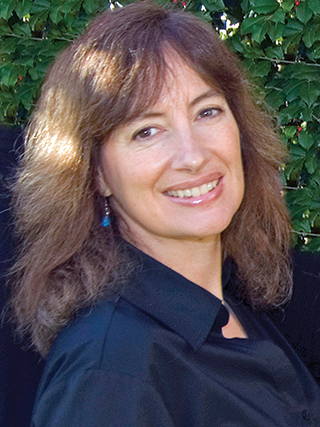
INFLUENTIAL — Susan Rempe (8635) has worked on Sandia teams that have won R&D 100 and Federal Laboratory Consortium awards. “Susan has made important contributions to diverse fields,” says her manager, Eric Ackerman.
Sandia’s Susan Rempe was named to the 2015 class of Albuquerque Business First’s Women of Influence for her professional achievements, leadership, and community involvement. “I’m excited about the award because it’s unusual for a scientist to be recognized as influential in the business world,” Susan (8635) says.
She is one of 30 honorees chosen from 450 nominees, and will receive the award at a gala March 12 at the Hyatt Regency in downtown Albuquerque.
Susan is a nanobiologist whose field is molecular modeling, and she has worked on three major projects at Sandia. One is a technology that helps regulate carbon dioxide emissions from electricity-generating plants and other industrial activities. Her team’s nano-stabilized enzymatic membranes for CO2 capture provide a simple, more energy-efficient approach than conventional methods. The work won a national Federal Laboratory Consortium (FLC) award.
Susan also helped develop biomimetic membranes, a revolutionary advance in the field of membrane technology for water filtration. The biomimetic membrane is inspired by the way the human body filters water and is designed for water purification using reverse osmosis, which removes impurities with applied pressure powered by electrical energy. Biomimetic membranes can increase access to clean water by dramatically reducing energy use and costs. The technology received R&D 100 and FLC awards.
And Susan has worked with the MD Anderson Cancer Center in Houston on a problem involving an enzyme used to treat childhood leukemia that causes serious side effects. Susan’s team showed how to control the side effects by eliminating a side-reaction catalyzed by the enzyme. Susan and her colleagues are studying ways to use the enzyme in different cancer treatments.
“Susan collaborates with top experimental scientists on important problems so that her models and predictions can be tested and refined,” says Eric Ackerman, manager of Nanobiology Dept. 8635, who nominated Susan for the award. “When her part of a multidisciplinary project is successful, her models save the experimentalists years of work and hopefully lead to revolutionary breakthroughs.”
A thumbs down to medicine
Susan grew up in northwest Montana with an early love of science. As a high school senior she used ultraviolet spectroscopy to assess the water quality in Flathead Lake near her home. She graduated first in her class of about 500 students. “I thought I would become a doctor or a veterinarian,” she says. “I was curious about all kinds of things.”
She attended Columbia University in New York City as a pre-med, majoring in German literature and history. After college she married, started a family, and decided medicine wasn’t for her. She went back to school and earned a bachelor’s degree in chemistry from the University of Montana and a master’s and doctorate in physical chemistry from the University of Washington. “Physical chemistry explained all my questions in the world,” she says.
She planned to become a high school chemistry teacher until she ran into Sandia’s Jim Martin (1114), who was recruiting at Washington. “He told me Sandia is about science and solving fundamental problems, and about national security,” she says. “I could do what I wanted science-wise. He said I could find colleagues with any expertise I needed. It sounded like a place I would like to work.”
Research with a purpose
Susan started at the Labs in September 2001 and a few years later was among the first to join the newly formed biosciences center. “This organization suits my interest in fundamental science and fundamental biological chemistry and materials,” she says. “There’s an applied end, a purpose for the research.”
Susan has published extensively in scientific journals and was invited for the prestigious Wilsmore Fellowship at the University of Melbourne, Australia. She is an adjunct professor of biology at the University of New Mexico. She has been invited to speak internationally at scientific meetings including Gordon Conferences and Telluride Workshops and to organize scientific conferences. She is a treasurer/secretary of a sub-group of the Biophysical Society.
Susan does white-water kayaking and back-country telemark skiing in her spare time, and is an accomplished pianist who has performed with the Symphony Orchestra of Albuquerque. She also volunteers in the community with such organizations as the Girl Scouts of America and at science fairs.
Susan says employers and female employees should take steps to bring more women into leadership roles. “Female leadership should be a top priority,” she says. “And the criteria for success and promotion must be based on specific measurable accomplishments.”